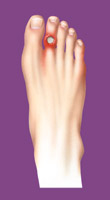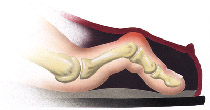

 |  |
DIABETIC FOOT PROBLEMS
|
n Causes n Foot Deformities |
n Ulcers of the Foot n Foot Surgery in the Diabetic Patient |
n Footwear Guidelines n Footcare Guidelines |

![]() Foot problems are
a leading cause of hospitalization for the 8 million persons in the
United States who have been identified as having diabetes mellitus.
Expenditures related to diabetic foot problems total hundreds of
millions of dollars annually. It is estimated that 15% of all
diabetics will develop a serious foot condition at some time in
their lives. Common problems include infection, ulceration, or
gangrene that may lead, in severe cases, to amputation of a toe,
foot or leg.
Foot problems are
a leading cause of hospitalization for the 8 million persons in the
United States who have been identified as having diabetes mellitus.
Expenditures related to diabetic foot problems total hundreds of
millions of dollars annually. It is estimated that 15% of all
diabetics will develop a serious foot condition at some time in
their lives. Common problems include infection, ulceration, or
gangrene that may lead, in severe cases, to amputation of a toe,
foot or leg.
Most of these problems are preventable through proper care and regular visits to Dr. Valerie A. Brunetti. She can provide information on foot inspection and care, proper footwear, and early recognition and treatment of foot conditions.
Foot problems in persons with diabetes are usually the result of three primary factors: neuropathy, poor circulation, and decreased resistance to infection. Also, foot deformities and trauma play major roles in causing ulcerations and infections in the presence of neuropathy or poor circulation.
n Neuropathy (Nerve Damage)
Your ability to detect sensations or vibration may be diminished. Neuropathy allows injuries to remain unnoticed and untreated for lengthy periods of time. It may cause burning or sharp pains in feet and interfere with your sleep. Ironically, painful neuropathy may occur in combination with a loss of sensation. Neuropathy can also affect the nerves that supply the muscles in your feet and legs. This ■motor neuropathy■ can cause muscle weakness or loss of tone in the thighs, legs, and feet, and the development of hammertoes, bunions, and other foot deformities.
n Poor Circulation
Persons with diabetes often have circulation disorders (peripheral vascular disease) that can cause cramping in the calf or buttocks when walking. The symptoms can progress to severe cramping or pain at rest, with associated color and temperature changes (the feet may turn bright red when hanging down and constantly feel cold). Also, the skin may become shiny, thinned and easily damaged. A reduction in hair growth and a thickening of the toenails might also be present.
Poor circulation, resulting in reduced blood flow to the feet, restricts delivery of oxygen and nutrients that are required for normal maintenance and repair. Healing of foot injuries, infection or ulceration is affected. Peripheral vascular bypass operations may avert lower extremity amputation.
n Infection
Persons with diabetes are generally more prone to infections than non-diabetic people. Due to deficiencies in the ability of white blood cells to defend against invading bacteria, diabetics have more difficulty in dealing with and mounting an immune response to the infection.
Infections often worsen and may go undetected, especially in the presence of diabetic neuropathy or vascular disease. Often, the only sign of a developing infection is unexplained high blood sugar, even without fever. The combination of fever and high blood sugar often warns of a severe infection requiring hospitalization. Lesser degrees of infection are often treated on an outpatient basis.
Foot deformities such as hammertoes, bunions, and metatarsal disorders have special significance in the diabetic population. Neuropathy places the foot at increased risk for developing corns, calluses, blisters and ulcerations. If these are left untreated, serious infections may result.
Special deformities can occur in persons with neuropathy and very good circulation. A Charcot joint, resulting from trauma to the insensitive foot, causes the foot to collapse and widen. This destructive condition is often first heralded by persistent swelling and redness, mild to moderate aching, and an inability to fit into your usual shoes. If this occurs, it is important to stay off the foot and see Dr. Brunetti immediately.
 |
 |
An ulceration or ulcer is usually a painless sore at the bottom of the foot or top of the toes, resulting from excessive pressure at that site. Ulcers frequently underlie a pre-existing corn or callus that was allowed to build up too thickly. Trauma from heat, cold, shoe pressure, or penetration by a sharp object are also potential causes. Neuropathy allows the lesions to develop because the normal warning sense of pain has been lost and they go unrecognized. Continued pressure or walking on the injured skin creates even further damage and the ulcer will worsen. The open sore will frequently become infected and may even penetrate to bone.
Treatment relies on early recognition of the ulceration by a podiatric surgeon, avoidance of weight bearing activities such as walking, avoidance of wearing "closed-in" shoes, and early intervention. Besides local wound care, dressings and antibiotics, other measures may be necessary to adequately relieve pressure on the area. When use of crutches, a wheelchair, or rest is not feasible, plaster casts, braces, healing sandals, or orthoses (special shoe inserts) can be used to protect the foot while it heals. If circulation is inadequate to allow healing, Dr. Brunetti may refer you to a vascular surgeon for appropriate evaluation and possible vascular reconstructive surgery.
Once an ulcer has healed, it is important to continue to see Dr. Brunetti regularly. Special footwear and inserts may be recommended to protect your feet and prevent new or recurrent lesions from developing.
Foot Surgery in the Diabetic Patient
Realizing the potential danger of foot deformities in the diabetic patient, corrective foot surgery is an option when you are in generally good health and have good circulation. Most deformities progressively worsen over time as do the effects of neuropathy and vascular or circulatory disease. When foot deformities cannot be managed effectively with conservative care, surgery may be indicated.
Podiatric surgery is often "same day" surgery under local anesthesia to minimize potential complications. In some cases, such as in the presence of an active ulceration, hospitalization may be necessary to properly monitor your postoperative progress.
Surgery may also be required to heal an ulceration or to eradicate some infections, especially those involving the bone. Your cooperation is an important part of your care. You must guard against injury and provide the daily care necessary to maintain the health of your feet.
Shoes must always fit comfortably and have adequate width and depth for the toes. Leather shoes easily adapt to the shape of your feet and allow them to "breathe." Athletic shoes, jogging shoes and sneakers are usually excellent choices if they are well fitted and provide adequate cushioning. Dr. Brunetti may recommend "extra depth" shoes, custom molded shoes to adapt to your particular needs, or orthoses to provide cushioning and support.
Always check your shoes for foreign objects or torn linings before putting them on. You should wear two or three pairs of shoes each day so that one pair is not worn for more than four to six hours. New shoes should be worn for only a few hours at a time, and you should take care to inspect your feet for any points of irritation.
Socks should be well fitted without seams or folds. They should not be so tight as to interfere with circulation. Well-padded socks can be very protective if there is an abundance of room in your shoes.
Avoid wearing open-toed shoes or sandals until you have discussed this with Dr. Brunetti. Above all else, do not walk with bare feet.
l Inspect your feet daily for blisters, bleeding, and lesions between your toes.
l Use a mirror to see the bottom of your foot and heel.
l Do not soak your feet unless the temperature of the water is lukewarm, not as hot as you can stand it. (95ľ100 degrees Fahrenheit).
l Avoid temperature extremes Ś do not use hot water bottles or heating pads on your feet.
l Wash your feet daily with warm, soapy water and dry them well, especially between the toes.
l Use a moisturizing cream or lotion daily, but avoid getting it between the toes.
l Do not use acids or chemical corn removers.
l Do not perform "bathroom surgery" on corns, calluses, or ingrown toenails.
l Trim your toenails carefully and file them gently. Have a podiatrist treat you regularly if you cannot trim them yourself without difficulty.
l Contact Dr. Brunetti immediately if your foot becomes swollen or is painful, or if redness occurs.
l Do not smoke.
l Learn all you can about diabetes and how it can affect your feet.
l Have regular foot examinations by Dr. Brunetti.
While these are some of the most commonly prescribed treatments for diabetic foot problems, others may be used. Dr. Brunetti will determine which treatment is likely to be the most successful in each case.
